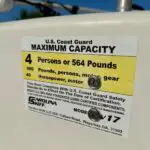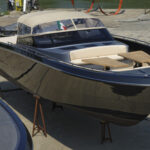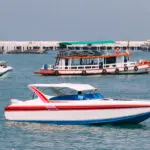The JV 17, according to Carolina Skiff, is easy to operate, simple, and stable.
But what makes this little boat so functional/practical? What are some of the pros and cons of using one? How many people can go on it? And what are its specifications?
I purchased my 2014 Carolina Skiff JV used a couple of years ago…and I fish on it 2-3 times per week.
In this boat review, I’m going to tell you (and show you) everything you need to know about these popular and great little boats!
Table of Contents
- Carolina Skiff JV 17 Review
- About My Personal JV 17 CC
- Handling & Driveability
- Carolina Skiff JV 17 Materials Used In Construction
- Carolina Skiff JV 17 Pros & Cons
- Carolina Skiff JV 17 Price & Availability
- Frequently Asked Questions
- Closing Thoughts
- Related Posts
Carolina Skiff JV 17 Review
The JV 17 Carolina Skiff is a popular 17-foot boat. Although they are no longer in production, several “newer” secondhand models are available. The primary purpose of a JV 17 is for fishing; however, they are versatile and make great run-around boats popular with many water users.
Carolina Skiff designed the JV series as a small, manageable run-around boat with a proclivity for fishing trips.

Below, we’ll investigate the JV 17 according to its physical characteristics, purpose, capacity, pros and cons, and popularity. And I’ll give you my honest feedback on my JV17 as well.
JV 17 Physical Specifications
JV 17’s are small, lightweight vessels usually sport a center console, but there is a tiller handle option for these boats.
The table below summarizes some of the principal physical features/specifications of the JV 17 Carolina Skiff.
| Specification | JV 17 Carolina Skiff |
|---|---|
| Length | 16 feet 8 in. |
| Dry weight | 750 lbs. |
| Beam | 64 in. |
| Gunnel height | 14 in. |
| Transom height | 15/20 in. |
| Draft | 3 in. |
| Standard Horsepower | 40 hp |
| Fuel capacity | 6 gal. |
Some of the common features include:
- 1x Bow eye
- 2x Stern eyes
- 2x 11ft. Extension poles
- 2x Swivel padded seats
- 2x Stainless steel base plates
- 4x 11×19 Hatch covers for storage
- 12V Trolling motor plug and battery tray
- 2x 6 1/2 gallon portable fuel tank
- 500 Gallon bilge pumps
- 4x Stainless steel cleats
- 2x 3 Stage rod holders
- Aerator pump
- Binnacle controls with wiring harness
- Control cables
- Console cushion set
- Heavy-duty rub rail
- HK premium gel coat
- Horn
- Full instrumentation (Speed, Fuel, Volt, Tach)
- LED bow light / stern light
- Lockable access door
- Quick disconnect windshield
- Smart tabs SX9510-30
- Self bailing hull
- Speckled interior finish
- Stainless steel grab rail
- Stainless steel steering wheel
- Steering cables
- Tilt Helm
Not all models have all of these features. Those purchased secondhand often deviate from some of the standard features due to customization, and aftermarket additions.
There are also extras that you can add, including:
- Additional rod mounts
- Additional pedestal seats
- LED lights along the deck
- Stainless Steel hardware
- Bimini Top
About My Personal JV 17 CC
To give you a real-world comparison of the standard features below is a description and photos of my personal JV17 CC.
I have the center console option with a 4-stroke Suzuki 40 hp outboard motor. I have the raised front deck, and swivel pedestal seats (which are removable). One in the front and one in the back.


My boat has two batteries, one in the back below the transom hatch that powers the console electronics (Hummingbird Helix 5 fish finder), navigation lights, bilge, aerator, horn, etc.
The previous owner also installed a trolling motor on the bow, which is a Minn Kota RipTide 12-volt with a 55 lb thrust (remote-controlled option).
See Also: How To Choose A Trolling Motor For Carolina Skiff Boats
It is powered by a deep cycle battery below the front deck and directly wired to the trolling motor and onboard charger.
My vessel has a total of 2 storage hatches under the front deck, one under the console seat (that can also be used as a cooler because it has a drain plug), large storage under the bench seat behind the console, and then an access hatch on the port side rear for the fuel tank.
The fuel tank is external and has a 6-gallon capacity and it’s easy to remove out of the transom hatch. The Livewell is located on the starboard rear side, which is very convenient for the driver.
Handling & Driveability
Okay now that we got the physical features out of the way, what about how the boat drives and handles?
The JV17 is a fairly narrow boat, with low gunnels. For that reason alone, illustrates that it’s not ideal for rough or heavy seas.
Does that mean it can’t handle a little chop? No, of course not. I regularly take my vessel on the Intercoastal waterway in the Indian River Lagoon (especially during the mullet run) and have no issues.
I’ve even poked outside of Sebastian Inlet on calm days, and the boat does very well.

Where I think the Carolina Skiff really shines is in freshwater, and inshore saltwater fishing.
However, in a strong cross wind with anything over 1-foot chop you likely going to get wet. The low gunnels and modified flat-bottom don’t ‘cut‘ through the chop like other comparable boats that are bigger and heavier.
With two people, fuel, and gear my boat will hit exactly 30 mph on a calm day. Not exactly a speed demon eh?
That’s okay with me…I’m not racing anyone and it’s plenty powerful enough to get up onto a plane…
However, again if it’s rough, and you’re facing a stiff headwind and heavy chop, this boat can struggle to get on and maintain a plane without getting wet or pounded in the waves.
I think it’s important, with any vessel to know its limitations and pick and plan your days accordingly. Choose where you launch, find leeward areas, and protected bays, and plan your route to minimize cross winds and heavy chop.
Carolina Skiff JV 17 Materials Used In Construction
The JV 17, like all other Carolina Skiff models, is constructed from 100% composite material. Composite material is a synthetic substance combining two different materials to form a new one.
The fiberglass used to make Carolina Skiffs is strong and durable, with very little bend once set. It is particularly malleable before the fiberglass sets, and manufacturers can mold it to any required shape.
Carolina Skiff JV 17 Pros & Cons
When evaluating a JV 17, we need to examine some of the pros and cons:
The Pros Of A JV 17
- Used JV 17 are popular, sturdy boats, and many models from 2016 are still available from reputable dealers.
- Most JV 17s are affordable/reasonably priced (I purchased mine for $9,000 with only 15 hours on the motor!)
- Due to their composite material construction, these boats are durable and last for many years, provided they are looked after well.
- The JV 17 is fuel-efficient.
- Their small size is ideal for a quick run-around, or mucking about on the lake when launching a larger boat is impractical.
- According to Carolina Skiff, these boats are stable, simple, and easy to handle (and I can personally attest to this!).

The Cons Of A JV 17
- No longer available on the market as new boats. Stock is limited to those who want to sell their old boats, and depending on how well the owners looked after boats; you might not find a good quality JV 17 on the market.
- They are a rough ride in choppy water. Flat bottom and modified V-hull boats are great in calm backwater conditions, but they start to beat and bash you around as soon as the swell picks up over 1.5 feet.
- They can only take a 40-50 HP outboard motor, so power is limited. Activities like towing a tube or skiing are not always feasible.
- The JV 17, like most fiberglass boats, is at risk of developing hull blisters and requires barrier treatments periodically.
- Their smaller size and narrow beam limit how many people you can take on board. Two people is perfect…3 is okay…and 4 is crowded.
- These vessels are not designed to go offshore and it is not recommended to try.
Carolina Skiff JV 17 Popularity & User Opinion
Overall, the JV range of Carolina Skiff met with mixed feelings. Some love the little boats for what they are, simple, easy, run-around boats designed for fishing and “frolicking” in the backwaters and lakes.
Other people, however, cannot get past the uncomfortable ride in rougher waters.
Some owners experience the delamination issue, to which Carolina Skiff provides a 10-year warranty (in models post-2019).
The JV 17 was and continues to be popular with most people who buy them. They won’t sail you across the Atlantic, but you probably don’t want that if you consider a Carolina Skiff.
Carolina Skiff JV 17 Price & Availability
Unfortunately, the Carolina Skiff JV 17 model is no longer in production. The entire JV line was discontinued in the late 2010s and replaced by the JLS and LS line of boats.
The secondhand price of the JV 17 Carolina skiff (according to Boat Trader and similar sites) is between $7,995 and $16,000.
When purchasing used boats, be certain that you work through reputable dealers, and if you do a private sale, make sure you inspect all aspects of the boat and take it for a test run before purchasing it.

Frequently Asked Questions
Where Would You Use A JV 17 Carolina Skiff?
When Carolina Skiff designed these boats, they were made for utility. Due to these boats’ size, weight, and draft, they work exceptionally well in shallow and calm waters.
Although they are versatile, JV 17 (and most Carolina Skiffs in general) make exceptional fishing boats when running in lakes, backwater rivers, bays, lagoons, and other areas with relatively little chop (waves).
Can A JV17 Carolina Skiff Go In 3 Inches Of Water?
On paper, the JV17 has a draft depth of 3 inches, but that does not mean that it will be able to always go in that shallow water.
There are certain limiting factors when determining the draft depth, including:
- Weight and balancing of the boat. The heavier the boat, the deeper it sits in the water.
- The lengths of your outboard/trolling motor shaft and the size of the propellers. If your props protrude too far below your boat, they’ll limit your minimum depth.
- The substrate of the water body. Going too shallow would be unwise if there are many large rocks on the water body’s floor.
- The conditions on the water body. Choppy water causes your boat to move up and drop down, which could be problematic in shallow water.
Aside from these physical limitations, what you’re trying to achieve also determines your minimum depth. If you’re fishing, you probably won’t be too shallow, the same as if you’re pulling your kids on a tube; you’ll need to be deeper.
How Many People Can Fit On A JV 17 Carolina Skiff?
The JV 17 is a relatively small boat and can only accommodate 4 adults of 564 pounds. The total weight the boat can carry is 980 lbs.

If you have a group of children or smaller teenagers, theoretically, you could fit more people on (regarding the weight restriction).
The JV 17 is a narrowboat with a 64-inch beam; therefore, space will become a factor.
Due to the smaller outboard motor capacity, anything greater than this weight will cause additional drag and result in the boat sitting too low in the water.
However, with the correct amount of weight and passengers, you’ll hit 29/30 knots relatively easily.
Where can I buy a used Carolina Skiff JV 17?
Check popular used boat marketplaces such as boattrader.com, boatersworld.com, and completeboat.com.
You can also check other online marketplaces such as craiglist.com (that’s where I found my boat), Facebook marketplace, and eBay.
And lastly, don’t overlook any marinas, boat houses, dealers, and even bait and tackle shops in your area. These businesses are often in the loop when it comes to used boats for sale and can often help.
Closing Thoughts
I love my Carolina Skiff JV17, plain and simple. It’s extremely fuel-efficient, lightweight, and perfect for up to two anglers.
This helps keep maintenance costs down, and fuel costs low and makes it easy for me to do basic repairs or fish and launch by myself.
I primarily fish freshwater lakes and rivers, and inshore saltwater (barrier islands, inlets, coves, and bays).

The Carolina Skiff is an affordable option, and a sturdy boat without all the bells and whistles. It’s a blue-collar vessel, but with plenty of options for upgrades.
If you looking for a large vessel, to hold the entire family and run around in the ocean or large bodies of water…this may not be the boat for you. It’s just not designed to withstand heavy waves or an abundance of weight.
However, if you’re looking for a great fishing style skiff, capable of doing a bit of everything at an affordable price…see if you can find a used JV17 in your area.
Thanks for reading, and good luck!
You May Also Like: Carolina Skiff vs Boston Whaler: Small Skiff Review

Growing up in Florida, I’ve been surrounded by saltwater my entire life…and I love sharing my passion with others.
To learn more about why I started Saltwater Mecca, visit the ABOUT page.
Thank you for reading this article. Browse around & have some fun!





